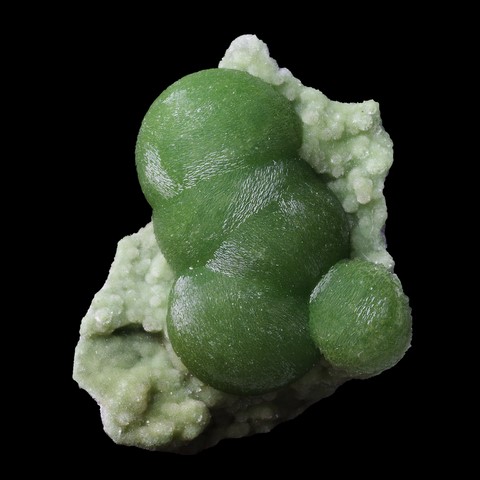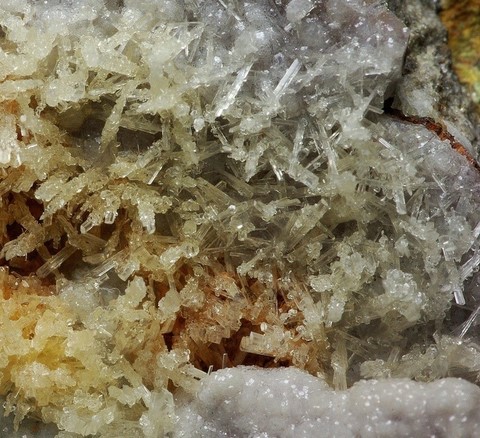WAVELLITE
Class : Phosphates, arsenates, vanadates
Subclass : Hydrated phosphates
Crystal system : Tetragonal
Chemistry : NaAl3(PO4)2(OH)4 2H2O
Rarity : Uncommon
Wavellite is one of the most common phosphates. It is a hydrated aluminum phosphate which is mainly formed in the cracks of hydrothermalized aluminous schists and pegmatites, more rarely in metallic deposits. It is usually associated with other phosphates (turquoise, vauxite, variscite, minyulite, etc...). Its name comes from the English physicist William Wavell who discovered the mineral in England at Barnstaple. Crystals, prismatic, are rare and generally very small. The wavellite presents itself almost exclusively in rosettes and fibroradiated aggregates of acicular crystals forming, under favorable conditions, spiky balls of crystalline points reaching 5 cm in diameter. More rarely it constitutes masses of chalcedonious or stalactiform aspect. The luster is pearly to silky, the color white to greenish, rarely clear green, exceptionally dark blue. Wavellite is no longer used in industry today, but it was once the source of match phosphor. It is a mineral that remains relatively unknown to collectors.
Wavellite in the World
Europe is well stocked with in particular, in addition to the specimens from Devon, the superb German samples from Tannenberg (Saxony) and Lichtenberg (Thuringia) where the fibroradiated spherolites white to yellow reach 15 mm.
Wavellite in France
In France, beautiful rosettes and white and colorless spherolites have been discovered in the pegmatites of Montebras (Creuse) : in this deposit the wavellite results from the decomposition of amblygonite with the leaching of lithium. Beautiful centimeter radiated globules associated with variscite were extracted from the Floquerie quarry near Pannecé (Loire-Atlantique). Very pretty white and transparent crystals in rods up to 5 mm associated with variscite have also been discovered in the Beauvoir kaolin quarry (Echassières, Allier), see photo on the left.
Twinning
Wavellite has no twinned crystals known.
Fakes and treatments
No scam known for this mineral.
Hardness : 3.5 to 4
Density : 2.36 to 2.37
Fracture : Irregular to sub-conchoidal
Trace : White
TP : Translucent to transparent
RI : 1.518 to 1.561
Birefringence : 0,026
Optical character : Biaxial +
Pleochroism : Hardly observable
Fluorescence : White to blue
Solubility : All acids
Magnetism : None
Radioactivity : None



